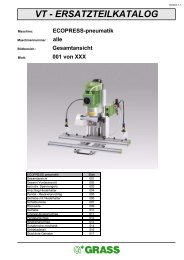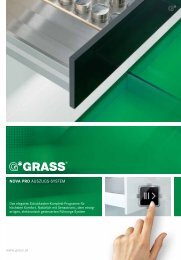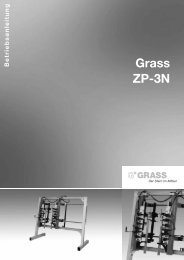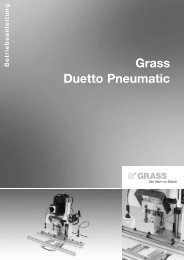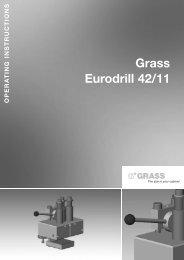7. operating the multipress - Grass
7. operating the multipress - Grass
7. operating the multipress - Grass
You also want an ePaper? Increase the reach of your titles
YUMPU automatically turns print PDFs into web optimized ePapers that Google loves.
8. TROUBLE-SHOOTING AND CORRECTIVE ACTION8-105 The bore head will not move down- Turn off <strong>the</strong> main switch.- Check <strong>the</strong> pneumatic lines.- Check <strong>the</strong> air pressure with <strong>the</strong> compressed air gauge (manometer). It should be 5.5 - 6 bar.- Check to make sure all pneumatic lines are secure and not loose inside <strong>the</strong> Multipress. The lines shouldalso not have any damage.- Adjust <strong>the</strong> non-return throttle valves “9” and “10” (illustration 4-002-03) in + direction as far as possible.- Loosen <strong>the</strong> pneumatic connection “1” by pressing in <strong>the</strong> ring “2” (illustration 8-004-01) and pull out <strong>the</strong>pneumatic hose. Pressing <strong>the</strong> start button should cause air to come out of this pneumatic line.Warning: Keep hands away from moving parts. If air comes out, <strong>the</strong>n <strong>the</strong> problem lies with <strong>the</strong> pneumaticcylinder. If no air comes out, <strong>the</strong>n <strong>the</strong> problem lies with <strong>the</strong> controls.- Make certain <strong>the</strong> exhaust arbor on <strong>the</strong> vertical bore head is clean. If <strong>the</strong> exhaust arbor gets stopped up,<strong>the</strong>n <strong>the</strong> compressed air cannot be released and <strong>the</strong> cylinder will not move down.If <strong>the</strong> above tips do not help, please call in a pneumatic technician (see pneumatic diagram, section 4-006).8-106 The components will not insert properly into <strong>the</strong> drillIllustrations 8-106-01 and 8-106-02Drill a hole pattern. Turn off <strong>the</strong> main switch. Mount an insertion die which corresponds to <strong>the</strong>hardware being installed. Place <strong>the</strong> hardware to be installed on <strong>the</strong> insertion die. Swing <strong>the</strong>insertion die arm down. Set <strong>the</strong> compressed air on <strong>the</strong> pressure reducer to 2 bar. Try to insert <strong>the</strong>component.a) The component is too far left or right.Loosen screw “1” (illustration 8-106-01) with a 4 mm Allen key. Slide <strong>the</strong> die left or right. Tighten <strong>the</strong>screw firmly again.b) The component is too close to <strong>the</strong> stop guide.Loosen <strong>the</strong> hexagon nut “2” (illustration 8-106-02) with a 8/10 mm fork wrench. Turn <strong>the</strong> hexagonnut “3” clockwise to screw out. Tighten <strong>the</strong> hexagon nut “1”.b) The component is too far away from <strong>the</strong> stop guide.Loosen <strong>the</strong> hexagon nut “1” (illustration 8-106-02) with a 8/10 mm fork wrench. Turn <strong>the</strong> hexagonnut “2” counterclockwise to screw in. Tighten <strong>the</strong> hexagon nut “1”.Complete point “b” on both sides of <strong>the</strong> insertion die arm.c) Test and check insertion process to see if <strong>the</strong> position is correct. If necessary, repeat steps “a” and “b”.The star in your cabinet95



